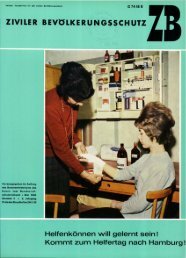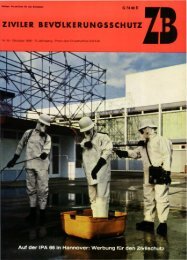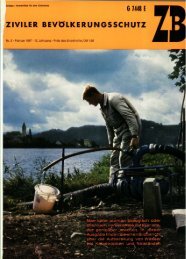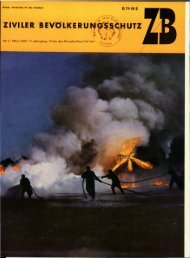Zivilschutz- Forschung - Bundesverwaltungsamt
Zivilschutz- Forschung - Bundesverwaltungsamt
Zivilschutz- Forschung - Bundesverwaltungsamt
Erfolgreiche ePaper selbst erstellen
Machen Sie aus Ihren PDF Publikationen ein blätterbares Flipbook mit unserer einzigartigen Google optimierten e-Paper Software.
7 Literatur<br />
1. Ackermann-Liebrich, U. A., C. Braun, et al. (1992). „Epidemiologic analysis<br />
of an environmental disaster: the Schweizerhalle experience.“ Environ<br />
Res 58(1): 1-14.<br />
2. Albanbauer, J., A. Kraatz, et al. (1983). „[Forensic chemical studies after<br />
bomb explosions].“ Arch Kriminol 171(3-4): 89-96.<br />
3. Alexeeff, G. V., M. J. Lipsett, et al. (1989). „Problems associated with the<br />
use of immediately dangerous to life and health (IDLH) values for estimating<br />
the hazard of accidental chemical releases.“ Am Ind Hyg Assoc J 50(11):<br />
598-605.<br />
4. Amshel, C. E., M. H. Fealk, et al. (2000). „Anhydrous ammonia burns case<br />
report and review of the literature.“ Burns 26(5): 493-7.<br />
5. Andersson, N. (1991). „Technological disasters – towards a preventive strategy:<br />
a review.“ Trop Doct 21 Suppl 1: 70-81.<br />
6. Andersson, N., M. Kerr Muir, et al. (1988). „Exposure and response to<br />
methyl isocyanate: results of a community based survey in Bhopal.“ Br J Ind<br />
Med 45(7): 469-75.<br />
7. Ayres, P. J. (1995). „Major chemical incidents – a response, the role of the<br />
Consultant in Communicable Disease Control and the case of need for a<br />
national surveillance-resource centre.“ J Public Health Med 17(2): 164-70.<br />
8. Baker, D. J. (1996). „Advanced life support for acute toxic injury (TOXALS).“<br />
Eur J Emerg Med 3(4): 256-62.<br />
9. Baker, D. J. (1996). „Advanced life support for acute toxic injury (TOXALS).“<br />
Eur J Emerg Med 3(4): 256-62.<br />
10. Baker, D. J. (1999). „Management of respiratory failure in toxic disasters.“<br />
Resuscitation 42(2): 125-31.<br />
11. Barach, P., A. Rivkind, et al. (1998). „Emergency preparedness and response<br />
in Israel during the Gulf War.“ Ann Emerg Med 32 (2): 224-33.<br />
12. Bastenier, H. (1978). „[Disaster of Seveso].“ Brux Med 58(1): 3-12.<br />
13. Baxter, P. J. (1990). „Responding to major toxic releases.“ Ann Occup Hyg<br />
34(6): 615-20.<br />
14. Baxter, P. J. (1991). „Major chemical disasters.“ Bmj 302(6768): 61-2.<br />
15. Baxter, P. J., B. J. Heap, et al. (1995). „Thetford plastics fire, October 1991:<br />
the role of a preventive medical team in chemical incidents.“ Occup Environ<br />
Med 52(10): 694-8.<br />
16. Beardsley, T. (1986). „Cameroon disaster: carbon dioxide blamed.“ Nature<br />
323(6083): 8.<br />
17. Beausang, E. and K. Herbert (1994). „Burns from a dust explosion.“ Burns<br />
20(6): 551-2.<br />
18. Beckett, W. S. (1998). „Persistent respiratory effects in survivors of the Bhopal<br />
disaster.“ Thorax 53 Suppl.2: 543-6<br />
222

















